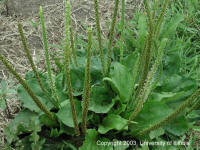 |

By John Fulton
[April 29, 2011] Everyone seems to have been waiting for warmer temperatures and the appointed date to begin broadleaf weed control programs. Well, that time will come, believe it or not. For most of the broadleaf products to work, the temperature has to be over 55 degrees.
|
The cool temperatures and high winds are playing havoc
with applications; however, the weeds are still growing. These
chemicals do work better when it is warmer and the weeds are
actively growing. The first item of business is to know what type of weeds you want to control. This will make a big difference in what product or products you select. The main products used for broadleaf weed control in lawns are 2,4-D, MCPP, dicamba, a combination of those three products, and triclopyr. Let's start with the triclopyr since it's probably the easiest to discuss. Its place in weed control is for hard-to-control weeds and woody plants. It also improves control of violets. It can be added to one or more other chemicals to provide broad-spectrum control. Some blends now contain trichlopyr, so check the label. There are many trade names for products containing trichlopyr, and they seem to change every year. Just check the active ingredients. The old standby for broadleaf control is 2,4-D. It is good on carpetweed, chicory, dandelion, lamb's-quarters, plantains and wild carrot. There are amine forms and ester forms. The esters will generally give better control of more weeds and are generally not water-soluble (except for a hard inch of rain soon after application), but they do have vapor drift potential. MCPP is good on chicory, lamb's-quarters and white clover.
Dicamba is good on black medic, chickweeds, chicory, dandelion, dock, henbit, knotweed, lamb's-quarters, pearlwort, purslane, red sorrel, thistles, white clover, wild carrot and yarrow. The combination of all three products will pick up all of those listed for the individual products, plus a few more such as mallow, speedwell and wild onion. The combinations are sold under many different trade names, so check the active ingredient list for ones you need. My annual disclaimer for application of these types of products is: "Beware of potential drift from these products." Not only can the spray move under windy conditions while you are spraying, but particularly with dicamba, the products can drift as a vapor for up to two weeks after spraying in hot and humid conditions. Frost on rhubarb and other fruits With a significant frost last week, many are questioning the effects on plants such as rhubarb. Yes, frosted rhubarb does release a poisonous acid from the leaves into the stems, but it usually takes a temperature of about 28 degrees to cause leaf damage. With most area temperatures reaching a low of 31 or 32, we would not expect the leaf damage. Check for yourself. Rhubarb leaves damaged by frost will first have water-soaked areas around the edges, then those areas will turn brown or black. If this does occur, you need to pull the stalks and start over. Effects on other fruits are similar. Most significant fruit production is not affected unless temperatures in the 28-degree range occur. Apples, peaches and apricots would all be in this same grouping. The annual plant sale by the Logan County Master Gardeners will be on Saturday from 9 a.m. to noon in the exhibition buildings at the Logan County Fairgrounds. The group has been working hard to get ready, so check out their offerings if you have a chance. They have quite a variety again this year, and they have not sold out in the past few years. [By JOHN FULTON, University of Illinois Extension]
|
 |






